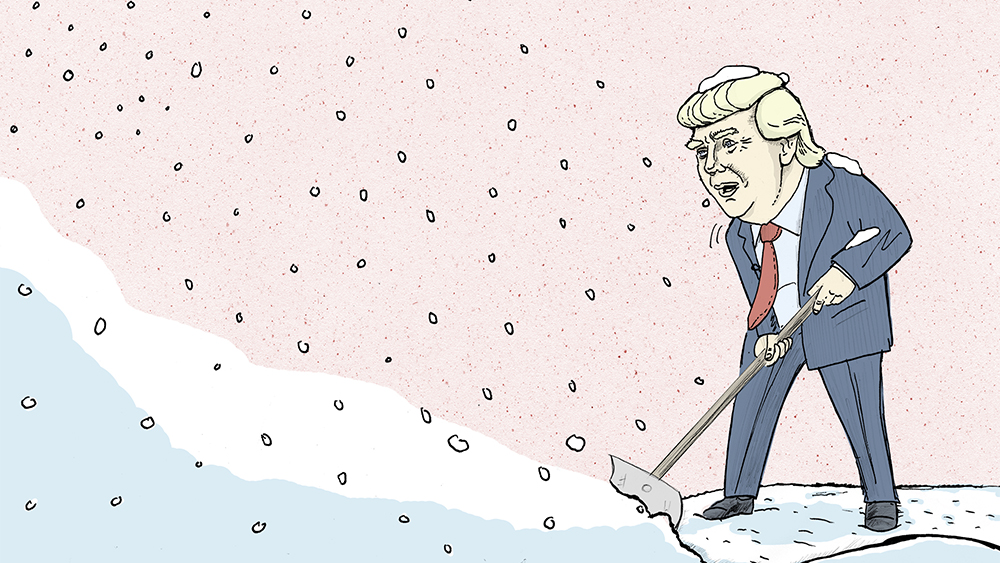Fragile, whiny, and weak: This is how US President Donald Trump and the right-wing portray their critics. But who’s the real snowflake?
It started as a quiet night in early February, as hundreds of well-meaning protesters at the University of California, Berkeley, took to the streets. The students wanted to shut down an on-campus speech by Milo Yiannopoulos, then the darling of Breitbart News. The university is known as the birthplace of the Free Speech Movement, but on that night students were determined to muzzle it – and with good reason. Yiannopoulos is known as a leader of the white nationalist “alt-right” movement, author of articles with headlines like “Birth Control Makes Women Unattractive and Crazy,” and has been permanently banned from Twitter for online harassment.
The peaceful protest morphed into a small riot, and Yiannopoulos’s speech was quickly cancelled. But it wasn’t a victory. In fact, it backfired spectacularly.
The protest was, after all, exactly what a professional provocateur like Yiannopoulos wanted. Critics on the right, including “Milo” himself, immediately called out the students, saying the incident proved they couldn’t deal with differing opinions. In other words, they were “snowflakes.”
Increasingly, conservatives are using the term to paint liberals as intolerant culture warriors hiding behind their trigger warnings and safe spaces – ever so precious and prone go into meltdown the moment they are faced with strongly-put opinions. According to the Collins English Dictionary, “snowflakes” are “the young adults of the 2010s, viewed as being less resilient and more prone to taking offense than previous generations.” Merriam-Webster (another dictionary clinging to 21st-century relevance with a new focus on social media buzzwords) tracked down the word’s origin to Chuck Palahniuk’s book Fight Club, published in 1996: “You are not a beautiful and unique snowflake. You are the same decaying organic matter as everyone, and we are all part of the same compost pile.”
Now, two decades later, “snowflake” has gone mainstream. And in the wake of the US presidential election, Donald Trump’s campaign manager Kellyanne Conway said millennial anti-Trump protesters were acting like “precious snowflakes.”
So what’s the big deal – can’t we all handle a little name-calling?
“Snowflake” is more than a social media meme, however. It represents a debate that has been raging for some time now: who decides when speech is socially acceptable? To many conservatives, the answer for too long has been: the liberals. They’ve grown tired of what they believe are leftist politically correct causes: gender neutral bathrooms, Black Lives Matter protests, and the growing string of letters after LGBT (it continues for another five: QIAPK – queer and questioning, intersexual, asexual, pansexual, polygamous, and kinkiness).
Donald Trump took advantage of this conservative frustration during his campaign, making it clear to his supporters that, unlike Hillary Clinton, he wouldn’t let political correctness stop him from building a wall to keep out Mexican “rapists” or ban Muslims from the US until he could “figure out what is going on.”
Similar frustration is boiling in Europe too. In the midst of the refugee crisis, some on the far-right in Germany created their own version of snowflake: “Gutmensch.” The word once simply meant do-gooder but it’s currently used as an insult for a person who blindly supports refugees.
It often seems there’s little common ground. Conservatives are called racists if they voted for Trump or Brexit, while liberals who fight for tolerance are labeled “snowflakes.” Where do we go from here?
One small step would be to bust out of our digital bubbles. After all, if we never encounter differing opinions online, we won’t know how to deal with them in the real world.
A project last summer helped demonstrate just how isolated liberals and conservatives are on the internet. The Wall Street Journal created a webpage with two different feeds side by side, a “red feed” and a “blue feed” consisting of news posts that a typical conservative or liberal would consume on Facebook. The page allowed users to choose a political topic like guns, immigration or abortion to see how the red and blue feeds framed the issue. Needless to say, each feed only served to reinforce preexisting notions.
Another step would be learning to listen. Hate speech should always be denounced, but liberals should scold less and listen more – if only because it’s more productive. In fact, Yiannopoulos eventually collapsed under the weight of his own words. After an online video surfaced in February in which he appeared to endorse sex between minors and adults, his book deal was canceled and he was forced to step down from his post at Breitbart.







